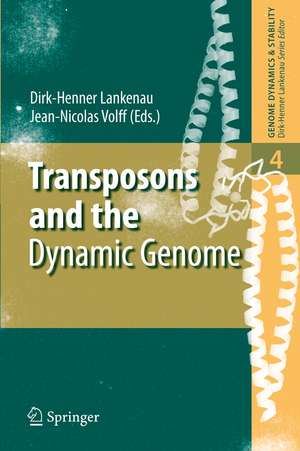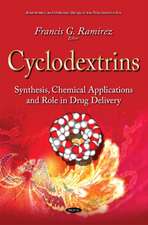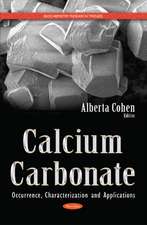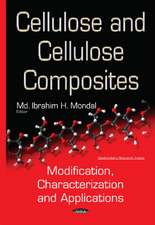Transposons and the Dynamic Genome: Genome Dynamics and Stability, cartea 4
Editat de Dirk-Henner Lankenau, Jean-Nicolas Volffen Limba Engleză Paperback – 29 noi 2011
| Toate formatele și edițiile | Preț | Express |
|---|---|---|
| Paperback (1) | 934.69 lei 6-8 săpt. | |
| Springer Berlin, Heidelberg – 29 noi 2011 | 934.69 lei 6-8 săpt. | |
| Hardback (1) | 948.16 lei 6-8 săpt. | |
| Springer Berlin, Heidelberg – 17 iul 2009 | 948.16 lei 6-8 săpt. |
Preț: 934.69 lei
Preț vechi: 1139.87 lei
-18% Nou
Puncte Express: 1402
Preț estimativ în valută:
178.88€ • 186.06$ • 147.67£
178.88€ • 186.06$ • 147.67£
Carte tipărită la comandă
Livrare economică 14-28 aprilie
Preluare comenzi: 021 569.72.76
Specificații
ISBN-13: 9783642242526
ISBN-10: 3642242529
Pagini: 200
Ilustrații: XV, 184 p.
Dimensiuni: 155 x 235 x 11 mm
Greutate: 0.29 kg
Ediția:2009
Editura: Springer Berlin, Heidelberg
Colecția Springer
Seria Genome Dynamics and Stability
Locul publicării:Berlin, Heidelberg, Germany
ISBN-10: 3642242529
Pagini: 200
Ilustrații: XV, 184 p.
Dimensiuni: 155 x 235 x 11 mm
Greutate: 0.29 kg
Ediția:2009
Editura: Springer Berlin, Heidelberg
Colecția Springer
Seria Genome Dynamics and Stability
Locul publicării:Berlin, Heidelberg, Germany
Public țintă
ResearchCuprins
Theoretical Approaches to the Dynamics of Transposable Elements in Genomes, Populations, and Species.- Infra- and Transspecific Clues to Understanding the Dynamics of Transposable Elements.- Morphological Characters from the Genome: SINE Insertion Polymorphism and Phylogenies.- Genome Defense Against Transposable Elements and the Origins of Regulatory RNA.- When Drosophila Meets Retrovirology: The gypsy Case.- Transposon–Host Cell Interactions in the Regulation of Sleeping Beauty Transposition.- Interactions of Transposons with the Cellular DNA Repair Machinery.
Textul de pe ultima copertă
There are only few major key functions that lie beneath the fundamental architecture of metabolism and life. These are multiplication, variation and heredity. Only if these factors interact synergistically can Darwinian selection power the evolution of biodiversity. Transposable elements have always played a major role in this process. The genomes of all organisms consist of chromosomes that are built up of double-stranded nucleic acid chains on whose stability and integrity the existence of cells depend. While DNA repair warrants the chemical integrity of DNA and protects it from metabolic and environmental mutagens, meiotic recombination and transposable element activity appear to counteract the molecular guardians of genome stability. Transposable elements and their kind often make up the bulk of genomic DNA, often approaching 50% of the genome. By contrast, the classic genes represent as little as 1.8% of genomic DNA, in case of the human genome.
This volume gives an overview on mobile DNA and how such contradiction to the obligatory stability of genomes can be understood. Obviously, an understanding can only be achieved by cutting deeply into the evolutionary history of life along with the evolution of transposable elements and dynamic genomes.
This book therefore also celebrates Charles Darwin’s 200th birthday. The reader is challenged to view the role of movable DNA along historical roots from the levels of cells to populations to biological species integrating the accompanying molecular evolution of host, cell and genome interaction. One will witness even the reactivation of a long since dead, fossil transposable element and the infection of germline cells by the first established, mobile and endogenous insect retrovirus.
This volume gives an overview on mobile DNA and how such contradiction to the obligatory stability of genomes can be understood. Obviously, an understanding can only be achieved by cutting deeply into the evolutionary history of life along with the evolution of transposable elements and dynamic genomes.
This book therefore also celebrates Charles Darwin’s 200th birthday. The reader is challenged to view the role of movable DNA along historical roots from the levels of cells to populations to biological species integrating the accompanying molecular evolution of host, cell and genome interaction. One will witness even the reactivation of a long since dead, fossil transposable element and the infection of germline cells by the first established, mobile and endogenous insect retrovirus.
Caracteristici
Includes supplementary material: sn.pub/extras
















